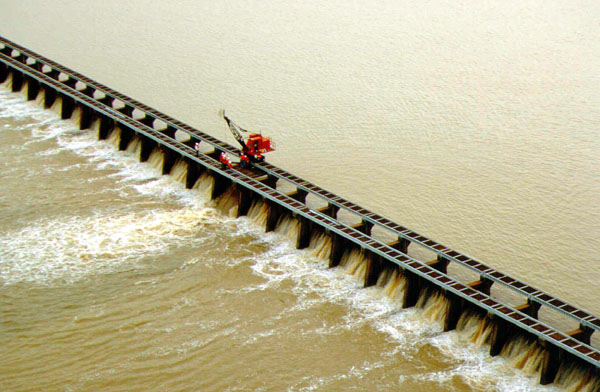Prior to the MR&T project, the east bank bluffs and the levee as originally built on the west bank from opposite Cairo, Illinois to New Madrid, Missouri, left only a narrow channel through which the river could flow at flood stage. To protect communities along the Mississippi and Ohio rivers and to reduce the flood heights to which the controlling levees on the Missouri side would otherwise be subjected, the MR&T project provides for a setback levee about 5 miles west of the riverfront levee through this reach. 
The strip between this setback levee and the levee adjacent to the river forms what is known as the Birds Point-New Madrid Floodway, operated only at extremely high stages. Water enters the floodway through lower levee sections or "fuse plugs" in the old front levee below Cairo and reenters the main river just above New Madrid. The floodway was operated in 1937 and aided in reducing flood heights at and above Cairo.
At the latitude of Red River Landing, the project flood is estimated at 3,000,000 cfs. The project provides for dividing this great quantity of water, with 1,500,000 cfs of the flow continuing down the main river channel, the remaining 1,500,000 cfs is being carried by the Atchafalaya River system.
Of the 1,500,000 cfs flowing down the main channel of the Mississippi River below Morganza Floodway, 250,000 cfs are to be diverted to Lake Pontchartrain and the Gulf through the Bonnet Carre´ Spillway, located about 25 miles above New Orleans. The remaining 1,250,000 cfs will continue down the river to the Gulf.
That portion of the flow diverted from the Mississippi River near Old River is carried by the Atchafalaya River, the Morganza Floodway, and the West Atchafalaya Floodway. The Morganza and West Atchafalaya floodways introduce flows down opposite sides of the Atchafalaya River until the end of the levee system along the Atchafalaya River is reached. There they merge into a single broad floodway that passes the flow to the Gulf through two outlets, Wax Lake and lower Atchafalaya River. In major floods, the Morganza would be the first of these two floodways to be used, with water entering it through a control structure just above Morganza.